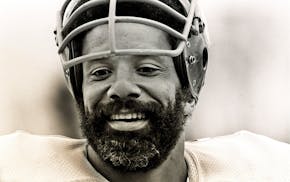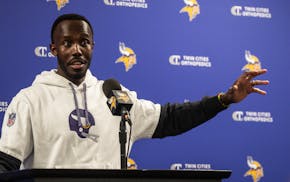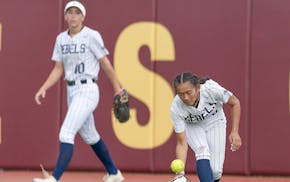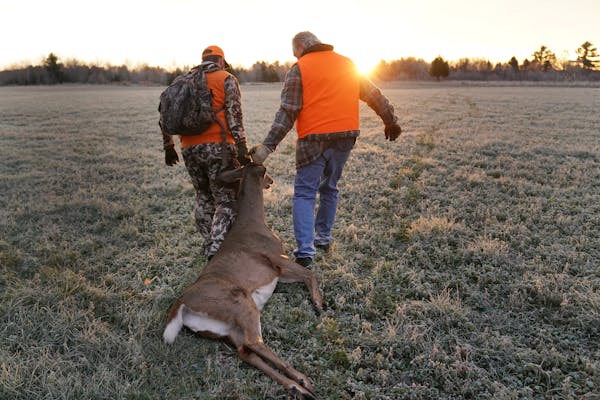All the traits that stand as well-worn advice in life are voiced in the context of hunting, too.
Patience, persistence, a narrow focus and preparedness can produce good, safe results and sometimes even great ones.
Such guidance was the collective message this week ahead of Minnesota's firearms deer season when board members from the Minnesota chapter of the conservation-minded Backcountry Hunters and Anglers (BHA), which has about 1,500 members, and others weighed in on favorite strategies, what they never leave home without and technology's rise — the stuff of the experienced hunter.
Also surveyed was Mark Norquist of Modern Carnivore, who creates podcasts, video and other media in support of the outdoors, and his friend and outdoorsman Ben Pena.
Pena, a Minneapolis Fire captain, has mentored adults new to hunting since 2014, and he also takes his two young boys out in the woods.
"I started deer hunting with my mother when I was 12 and haven't stopped," he said. "I bring a humble attitude and try to remember that nature is amazing and to have fun. That usually translates into not getting a deer, as I tend to be selective."
Here are some of the responses about public lands hunting (edited for length and clarity):
On a favorite early-season tactic
Mark Norquist: I take a fairly consistent and simple approach to the Minnesota deer opener. I scout for typical buck signs (tree rubs and ground scrapes) and then cross-reference them with well-established game trails. The challenge is then to find a tree with good sight lines where I can hang my stand. Where I hunt in the North Woods it can be hard to see even 40 yards in most areas. Once I've got my location established I sit as long as I can in that one spot, and that usually means I'm there all day. When the bucks are in rut I find it best to just wait for them to come to me, instead of trying to find them.
Eli Mansfield (BHA): Make a plan, stick to it and move on your decisions. On public land, you can get paralyzed by analysis. The best hunting tactic is to be out there hunting and not constantly changing your setup.
Aaron Hebeisen (BHA): Sit longer than you think you need to. Deer will move all day during the rut. You can't shoot them from the couch.
Leigh Neitzel: I have a bit of an advantage being able to hunt on private land. I have invested time and a lot of sweat equity into my deer stand. Each pre-season I make any necessary repairs and make sure all my equipment is in place. I also take the time to tidy up my shooting lanes. There is nothing worse than hitting a small sapling and missing that one shot you'll never get back. I only speak from experience!
Ben Pena: Get out early and get as far away from the road and parking lot as possible as fast as I can. And I stay out the entire day.
On a must-have item or gear
Chance Adams (BHA): Headlamp. The worst feeling is shooting a deer near sunset and not having a light.
Tyler Notch (BHA): My Tree Saddle. I made the switch a few years back. Allows me to be mobile and hunt many places I couldn't get to with a stand on public land.
Mansfield (BHA): Tourniquet. Sounds extreme, but it can be the difference between saving your life or the life of your hunting partner. Accidents happen.
Neitzel: I never leave camp without a can of Vienna sausages. When I was a little girl, I would often visit my grandfather's deer stand and he was always heating a little can of Vienna sausages over an open fire. He would eat the entire can and then drink the juices. I carry a small can of those sausages with me every season. I call it, "Grandpa In A Can." He's always with me even though he has long since passed. I cannot imagine a deer season without them. Just writing this brings tears to my eyes.
Norquist: The key to effectively sitting and waiting all day for a deer is staying warm and being very quiet. I find that hunting clothes made of wool and fleece are great as they're wonderful insulators (even when wet) and very quiet when you move. You'd be amazed how much noise the wrong clothing can make when you do something as simple as turn your head.
Pena: I bring my Leica Geovid 10x42mm Rangefinder binoculars in a harness for fast access and security. Also, on public land, an inReach (satellite communicator) to track and for a safety net. Can't take chances when I'm out on my own.
On what to leave home
Notch (BHA): I leave the trail cams at home. It may be an unpopular opinion, but hunting the freshest sign is a sure way to know there are deer around.
Norquist: The video camera. While I take a lot of photos and videos around hunting camp I don't attempt self-filming the actual hunt. Mounting a camera on a gun, or over the shoulder creates a BIG distraction. I prefer to share my stories around the fire through conversation. The moment of the kill is something that should be respected — it's for you and the deer alone.
On technology's rise
Neitzel: Investing money into a quality trail camera is never a wrong move, but learning how to read the land and to identify deer signs, and increasing your knowledge of quality habitat and food, are essential pieces in placing that camera.
Hebeisen (BHA): The onX app and a rangefinder religiously get used. It helps me know the property and make an ethical shot.
Pena: I use what is legal first and foremost. But I will always have an old-school orienteering compass and a hard map of the area.
Adams (BHA): Cellular game cameras have changed the game for me. Seeing deer throughout the week leading up to the hunt really gets me excited.
A $2.8 billion settlement will change college sports forever. Here's how

Reusse: Country boy Jim Marshall never lost his lust for life

Twins open homestand with loss to Blue Jays, Jeffers ejected after critical call

Vikings GM talks to the Star Tribune about the team's 2025 outlook, McCarthy's trajectory




